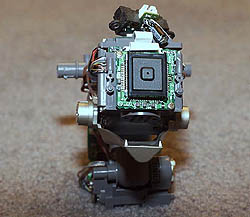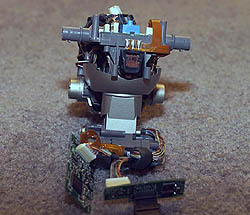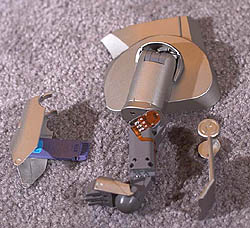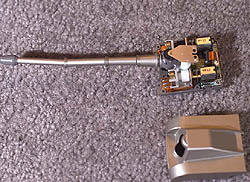|
As
with most technologies people are fascinated with how it
works. The temptation to undo all those nuts and bolts and
have a peek is irresistible. In computing the term used
to describe the unpacking of an object is 'tear down'.
Senses
and sensors
Animals use senses, such as vision, hearing, touch or smell,
to navigate, perceive and interact with their environment.
The Aibo has hardware and software that imitate some of
these senses to allow the Aibo to navigate its surroundings
and interact with users.
Control
memory processing
The Aibo control system uses microprocessors to monitor
input from hardware devices including:
- CCD
colour video camera
- stereo
microphone
- thermometric
sensor
- infrared
sensor
- three-axis
acceleration sensor.
Feedback
The Aibo must control the various robotic motors, audio
output and illuminated indicators, all of which offer feedback
to the owner or operator about how the Aibo is performing
and 'feeling'.
The
Aibo's exterior
The Aibo's shell is plastic. This material is used because
it is light. Sony tried to keep the weight of the Aibo as
light as possible so that less power was required to drive
the robot and the operating life of the power cell could
be extended. One large lithium-ion cell powers the Aibo
for approximately three hours. Although the shell is plastic,
the designers have been able to create an appealing lifelike
appearance.
The
tear down
Demystifying this new information technology product is
not easy. The table below is a starting point.
|
Machine
vision
The Aibo has a colour digital camera mounted in
the 'head' section. The image data from this camera
are vital in creating an interactive experience with
the Aibo, for example, tracking the pink ball that
comes with the Aibo.
The
video input is analysed to identify the Aibo's ball
or a 'hot spot'; the robotic motors shift the 'head'
to give the appearance that the Aibo is observing
the ball and the Aibo will advance towards it.
The
Aibo is also equipped with an infra-red distance sensor
to detect obstacles ahead and avoid running into them.
|
 A
Colour CCD camera Courtesy:
Moolabooga
A
Colour CCD camera Courtesy:
Moolabooga |
|
Audio
recognition
The Aibo is equipped with a pair of microphones,
one on each side of the head. These create a stereo
image of sound received, which aids in locating the
source of a sound.
An
Aibo comes with a remote controller that plays sound
files that the Aibo recognises as commands. An Aibo
is constantly roaming for commands received through
its microphones.
|
The
microphones are mounted on the axis of the ears.
Courtesy:
Moolabooga
|
|
Touch
The touch-sensitive pad on the top of an Aibo's
head is another mechanism through which it will receive
information.
Depending
on how this sensor is touched, an Aibo receives data
that registers positive or negative feedback in regard
to the previous 'behaviour', imitating demonstrations
of affection or reprimand.
|
 The
blue button is a pressure sensitive switch Courtesy:
Moolabooga
The
blue button is a pressure sensitive switch Courtesy:
Moolabooga |
|
Movement
and growth
Many of the Aibo's movements are similar to those
of a domestic animal, either a dog or a cat. This
is a facet of the product's design that plays upon
our identification with pets and further enhances
our identification with the product.
An
Aibo accesses and runs motion files which dictate
the movement of its limbs by controlling step motors
in the legs, head and tail.
In
autonomous (independent) mode an Aibo moves through
several stages over a period of time. When 'born'
the Aibo accesses a range of movement and sound files
that simulate very juvenile behaviour.
As an Aibo's hours of operation clock up and feedback
from the operator is noted, it will begin to access
new and more sophisticated movement files and appear
to advance as a learning and growing domestic animal
would.
|
 Aibo
leg module Courtesy: Moolabooga
Aibo
leg module Courtesy: Moolabooga |
| |

Aibo
tail module Courtesy: Moolabooga
|
|
Activity
- Visit
this link and take a look at more images of an Aibo in
pieces from the hardware section: http://www.aibosite.com.
|